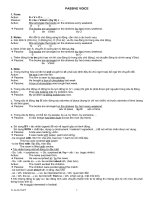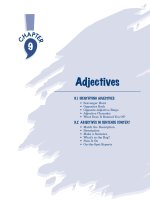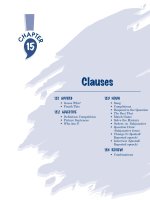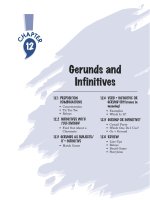fun With Grammar - Passive voice
Bạn đang xem bản rút gọn của tài liệu. Xem và tải ngay bản đầy đủ của tài liệu tại đây (220.1 KB, 11 trang )
Passive Voice
11
11.1 PASSIVE VOICE
• At the Movies
• Busy Pictures
• Match
• Storytime
11.2 PARTICIPIAL ADJECTIVES
• Reviews
• Pictures
11.1 PASSIVE VOICE
1. AT THE MOVIES
Materials:
Short excerpt from video
Worksheet based on video (see sample Worksheet 66)
Dynamic:
Small groups
Time:
40 minutes
Procedure:
1. Select either a short video (no more than 30 minutes) or an excerpt
from a longer video. Use about 10 minutes of an action-packed
scene. Go over vocabulary that the students will need in order to
understand the video and to write their sentences. I recommend
including this on the worksheet.
2. Go over the questions on the worksheet so the students know in
advance what to look for when you show the video. Use a variety
of tenses in your questions.
Examples:
What happened to the balloon?
What had already happened to the man before he entered
the cave?
What do you think will happen to the woman next?
Be sure the students understand that they must reply in the
passive. They cannot answer, “The balloon flew away,” to the first
question (above). They must answer with a response such as “The
balloon was taken by the gang of boys.” Students have a tendency
to answer in the active voice for a question in the future, so you
may want to solicit some responses in the passive or have the
students brainstorm answers to the questions in groups.
3. Show the video. Let the students take notes if they want.
4. Arrange the students in groups of three or four to discuss the
video and try to form answers to the questions.
5. For homework, have the students write out the answers to the
questions, using only the passive voice.
NOTE: Worksheet 66, intended as an example, is based on
approximately 10 minutes near the beginning of Raiders of the Lost
Ark, from the time Indiana Jones enters the cave until he flies off
in the airplane. Pick a short segment of a video with a lot of action,
one that lends itself to writing passive sentences.
216
217
2. BUSY PICTURES
Materials:
Picture for each student (see Worksheets
67A & 67B for examples)
Dynamic:
Individuals/Groups
Time:
25 minutes
Procedure:
1. Choose a picture with a lot of activity. Be sure that students will
be able to generate some passive sentences about the picture you
have chosen. A funny or strange picture works well. Good sources
for pictures are magazine ads, certain comics, and pictures from
lower-level writing books.
2. Have students write a specific number of sentences in the passive
based on the picture. Have an advanced class write a paragraph
that contains both passive and active sentences. Tell them not to
limit themselves to what they see in the picture. Encourage them
to stretch their imagination and be creative. The funnier and more
outrageous the situations or sentences, the more fun the activity
will be. Give them some help to get started. For example:
Last weekend I was at a very elegant restaurant where the
food was being served by a sophisticated-looking waitress
when . . .
I had dinner with my girlfriend’s parents for the first time.
As the menu selections were being discussed, I leaned back
to drink my water and suddenly . . .
If you are asking for a paragraph, make sure the students
understand that it is impossible to write every sentence in the
passive, so their paragraphs will be a mixture of passive and
active sentences. You may want to tell them approximately how
many passive sentences you would like them to produce.
3. Collect and correct the students’ sentences, then prepare an error
analysis page focusing on mistakes in the passive taken from their
writing (see Worksheet 67B). Different types of mistakes may be
included, such as
The waitress is brought the meal.
The menu are being discussed by the women.
The meal is being serving.
4. Before handing back the students’ work, arrange the students in
small groups and have them try to correct the errors on the error
analysis page. The individual students can use these corrections to
help with their own papers when they are returned.
3. MATCH
Materials:
Worksheet 68
Dynamic:
Pairs/Small groups
Time:
20 minutes
Procedure:
1. Arrange students in pairs or groups of three or four, and give a
copy of the worksheet to each group.
2. The students are to choose two related words on the worksheet
and make a passive sentence using them. They will have to supply
their own verbs and other words.
Words chosen: children, Aladdin
Possible sentence: Aladdin is loved by children.
Words chosen: dog, bone
Possible sentence: Bones are eaten by dogs.
3. As a follow-up the next day, you might make a worksheet of
inappropriate passive sentences. The students would correct the
sentences and explain what was wrong: the sentences are illogical,
silly, do not have correct subject/verb agreement, or do not use the
passive.
4. STORYTIME
Materials:
Worksheet 69
Dynamic:
Small groups
Time:
30 minutes
Procedure:
1. Arrange students in groups of three or four. Give each group a
copy of the worksheet.
2. Direct students to read the short summaries on the worksheet and
then write four sentences based on the readings, using the passive
voice.
Sample responses, Worksheet 69, story 1:
Lucy was fooled by her boyfriend, who was dressed as a woman.
Lucy is attracted to her disguised boyfriend.
Kevin and Mac are taken out to public places by Lucy.
Dates were arranged for the two men dressed as women.
NOTE: You can use summaries of soap operas (as in the handout),
movies, TV shows, stories the students are reading in their reading
classes, fairy tales, or fables, or make up your own.
218
219
11.2 PARTICIPIAL ADJECTIVES
1. REVIEWS
Materials:
Worksheet 70
Dynamic:
Pairs
Time:
15 minutes
Procedure:
1. To review participial adjectives, use the worksheet or make a
similar one of your own, based on a current TV show or movie.
2. Have students work in pairs (one worksheet per pair) to fill in the
blanks with the appropriate form of one of the verbs listed.
3. Go over the worksheet as a class and discuss the reasons for the
answers.
2. PICTURES
Materials:
A large picture for each pair
Dynamic:
Pairs
Time:
10 minutes
Procedure:
1. Put students into pairs. Give each pair a picture and a verb to use.
A good source of pictures is full-page ads in magazines.
2. The partners make a sentence based on their picture, using a
participial adjective form of the verb they have been assigned.
Examples:
Use a picture of a man watching TV. Assigned verb: bore
The man is bored by the programs on TV. or
The TV programs are very boring.
Be sure to assign a verb that can be logically used with the
picture. Sometimes different forms can be used, but other times
only one form is logical.
3. Each pair shows their picture to the class and reads their sentence.









